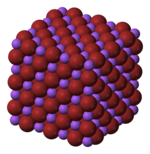Sodium bromide

| |

| |
| Names | |
|---|---|
| IUPAC name
Sodium bromide
| |
| Identifiers | |
| |
3D model (JSmol)
|
|
| ChEMBL |
|
| ChemSpider |
|
| ECHA InfoCard | 100.028.727 |
PubChemCID
|
|
| RTECS number |
|
| UNII |
|
CompTox Dashboard(EPA)
|
|
| |
| |
| Properties | |
| NaBr | |
| Molar mass | 102.894g·mol−1 |
| Appearance | White powder,hygroscopic |
| Density | 3.21 g/cm3(anhydrous) 2.18 g/cm3(dihydrate) |
| Melting point | 747 °C (1,377 °F; 1,020 K) (anhydrous) 36 °C (97 °F; 309 K) (dihydrate) decomposes[3] |
| Boiling point | 1,390 °C (2,530 °F; 1,660 K)[3] |
| 71.35 g/100 mL (−20 °C) 79.52 g/100 mL (0 °C) 94.32 g/100 mL (25 °C)[1] 104.9 g/100 mL (40 °C) 116.2 g/100 mL (100 °C)[2] | |
| Solubility | Soluble inalcohol,liquidammonia,pyridine,hydrazine,SO2 Insoluble inacetone,acetonitrile[1] |
| Solubilityinmethanol | 17.3 g/100 g (0 °C) 16.8 g/100 g (20 °C) 16.1 g/100 g (40 °C) 15.3 g/100 g (60 °C)[1] |
| Solubilityinethanol | 2.45 g/100 g (0 °C) 2.32 g/100 g (20 °C) 2.29 g/100 g (30 °C) 2.35 g/100 g (70 °C)[1] |
| Solubilityinformic acid | 19.3 g/100 g (18 °C) 19.4 g/100 g (25 °C)[1] |
| Solubilityinglycerol | 38.7 g/100 g (20 °C)[1] |
| Solubilityindimethylformamide | 3.2 g/100 g (10.3 °C)[1] |
| Vapor pressure | 1 torr (806 °C) 5 torr (903 °C)[3] |
| −41.0·10−6cm3/mol | |
| Thermal conductivity | 5.6 W/(m·K) (150 K)[4] |
Refractive index(nD)
|
1.6428 (24 °C) nKrF= 1.8467 (24 °C) nHe–Ne= 1.6389 (24 °C)[5] |
| Viscosity | 1.42 cP (762 °C) 1.08 cP (857 °C) 0.96 cP (937 °C)[1] |
| Structure | |
| Cubic | |
a= 5.97 Å[4]
| |
| Thermochemistry | |
| 51.4 J/(mol·K)[1] | |
Std molar
entropy(S⦵298) |
86.82 J/(mol·K)[1] |
Std enthalpy of
formation(ΔfH⦵298) |
−361.41 kJ/mol[1] |
Gibbs free energy(ΔfG⦵)
|
−349.3 kJ/mol[1] |
| Pharmacology | |
| Legal status |
|
| Hazards | |
| NFPA 704(fire diamond) | |
| Flash point | 800 °C (1,470 °F; 1,070 K) |
| Lethal doseor concentration (LD, LC): | |
LD50(median dose)
|
3500 mg/kg (rats, oral) |
| Safety data sheet(SDS) | External MSDS |
| Related compounds | |
Otheranions
|
|
Othercations
|
|
Except where otherwise noted, data are given for materials in theirstandard state(at 25 °C [77 °F], 100 kPa).
| |
Sodium bromideis aninorganic compoundwith the formulaNaBr.It is a high-melting white, crystalline solid that resemblessodium chloride.It is a widely used source of thebromide ionand has many applications.[7]
Synthesis, structure, reactions
[edit]NaBr crystallizes in the samecubicmotif asNaCl,NaFandNaI.Theanhydroussalt crystallizes above 50.7 °C.[7]Dihydratesalt (NaBr·2H2O) crystallize out of water solution below 50.7 °C.[8]
NaBr is produced by treatingsodium hydroxidewithhydrogen bromide.
Sodium bromide can be used as a source of thechemical elementbromine.This can be accomplished by treating anaqueous solutionof NaBr withchlorinegas:
- 2 NaBr + Cl2→ Br2+ 2 NaCl
Applications
[edit]Sodium bromide is the most useful inorganic bromide in industry.[7]It is also used as a catalyst in TEMPO-mediated oxidation reactions.[9]
Medicine
[edit]
Also known as Sedoneural, sodium bromide has been used as ahypnotic,anticonvulsant,andsedativeinmedicine,widely used as ananticonvulsantand asedativein the late 19th and early 20th centuries. Its action is due to the bromide ion, and for this reasonpotassium bromideis equally effective. In 1975, bromides were removed from drugs in the U.S. such asBromo-Seltzerdue to toxicity.[10]
Preparation of other bromine compounds
[edit]Sodium bromide is widely used for the preparation of other bromides inorganic synthesisand other areas. It is a source of the bromidenucleophileto convert alkyl chlorides to more reactive alkyl bromides by theFinkelstein reaction:
- NaBr + RCl → RBr + NaCl (R =alkyl)
Once a large need inphotography,but now shrinking, the photosensitive saltsilver bromideis prepared using NaBr.
Disinfectant
[edit]Sodium bromide is used in conjunction with chlorine as a disinfectant for hot tubs and swimming pools.
Petroleum industry
[edit]Because of its highsolubilityin water (943.2 g/L or 9.16 mol/L, at 25 °C) sodium bromide is used to prepare densedrilling fluidsused inoil wellsto compensate a possible overpressure arising in the fluid column and to counteract the associated trend toblow out.The presence of the sodiumcationalso causes thebentoniteadded to the drilling fluid to swell, while the highionic strengthinduces bentoniteflocculation.
Safety
[edit]NaBr has a very low toxicity with an oralLD50estimated at 3.5 g/kg for rats.[6]However, this is a single-dose value. Bromide ion is a cumulative toxin with a relatively longhalf-life(in excess of a week in humans): seepotassium bromide.
References
[edit]- ^abcdefghijkl"Sodium bromide".
- ^Seidell, Atherton; Linke, William F. (1919).Solubilities of Inorganic and Organic Compounds(2nd ed.). D. Van Nostrand Company.
- ^abcPradyot, Patnaik (2003).Handbook of Inorganic Chemicals.The McGraw-Hill Companies, Inc.ISBN978-0-07-049439-8.
- ^ab"Sodium Bromide (NaBr)".korth.de.Korth Kristalle GmbH. Archived fromthe originalon 2014-07-14.Retrieved2014-06-11.
- ^Polyanskiy, Mikhail."Refractive index of NaBr (Sodium bromide) - Li".refractiveindex.info.Retrieved2014-06-11.
- ^ab"Sodium bromide MSDS".sciencelab.com.Sciencelab.com, Inc. 2013-05-21. Archived fromthe original(PDF)on 2013-10-07.Retrieved2014-06-11.
- ^abcMichael J. Dagani, Henry J. Barda, Theodore J. Benya, David C. Sanders "Bromine Compounds" inUllmann's Encyclopedia of Industrial ChemistryWiley-VCH, Weinheim, 2000.doi:10.1002/14356007.a04_405
- ^Eagleson, Mary (translated by) (1994).Concise Encyclopedia Chemistry(Illustrated, revised, English language ed.). Berlin [u.a.]: Walter De Gruyter. p. 996.ISBN9783110114515.
- ^Hirota, Masayuki; Tamura, Naoyuki; Saito, Tsuguyuki; Isogai, Akira (2010). "Water dispersion of cellulose II nanocrystals prepared by TEMPO-mediated oxidation of mercerized cellulose at pH 4.8".Cellulose.17(2): 279–288.doi:10.1007/s10570-009-9381-2.S2CID97264888.
- ^"Bromide: Potassium & Sodium".canine-epilepsy.com.Canine-Epilepsy Resources. 2011-05-31. Archived fromthe originalon 2014-03-06.Retrieved2014-06-11.

